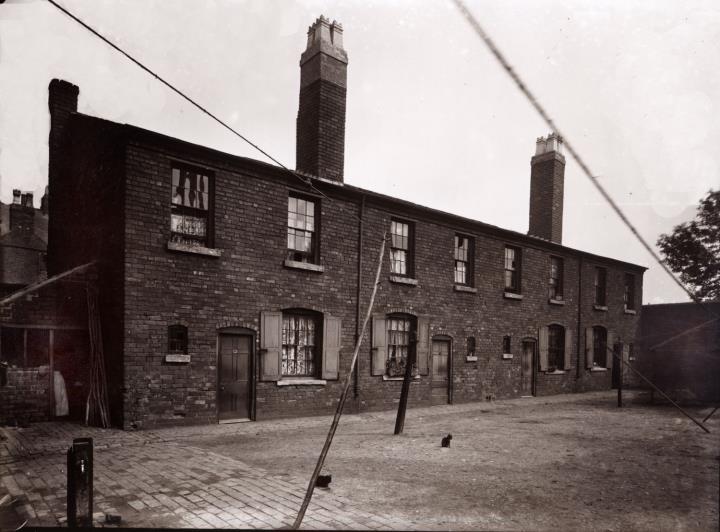
In Darkest Birmingham – housing and overcrowding in post WW1 Birmingham
Liz Palmer reflects on the post-WW1 housing crisis – and some of the parallels with today’s situation.
Health inequalities, job insecurities and working conditions, overcrowding and poor quality housing, educational attainment, access to open spaces and pollution – these are all subheadings I could include in an article about the disparities in Britain (& the rest of the world) highlighted by Covid19. But I’ve actually been looking at housing conditions and their ramifications in post-WW1 Birmingham. Plus ca change…..
Housing conditions in Birmingham, as with other major cities, had been a major issue for many decades even prior to WW1. Some of the more notorious slums, such as the Froggery, had been cleared during the redevelopment of the City Centre when Corporation Street was built as part of the Birmingham Improvement Scheme. But there had been a complete failure to rebuild houses for the inhabitants that lived and worked in the heart of the city although that had been the original intention of Disraeli’s 1875 Artisan’s and Labourer’s Dwellings Act. And remaining housing stock in Birmingham contained thousands of poor quality back-to-backs and courtyard style houses in rapidly deteriorating condition. These were constantly highlighted by the City’s Medical Officers’ of Health as being implicated in the health of their inhabitants and the high infant mortality rates.

Pigott Street, Lee BankBack-to-back housing in Pigott Street, Lee Bank. Now demolished, this row is nos. 9-12, in Number 2 Court. Pigott Street itself has disappeared, but was off the western end of Great Colmore Street. The …View Full Resource on Birmingham Images
It was no surprise then that housing was one of the major issues on which parliamentary (& municipal) candidates campaigned in the post war years. I’ve recently come across a short series of articles published in the Birmingham Daily Gazette in the winter of 1922 under the banner of ‘In Darkest Birmingham’ in which Dr John Robertson, Birmingham’s MoH, both highlights the problems relating to the city’s slums, which had been exacerbated by overcrowding, and more positively presents some possible solutions.
“Overcrowding is a civic disease which exists in more or less degree all the districts of Birmingham, with the possible exception of Edgbaston. But it is to be found at its worst in the central wards of the city, where the victims are among the poorest members of the community without work, without resources, and often enough, without anything that could be called furniture”
Dr Robertson explained why overcrowding had become such a problem. He pointed out that prior to the war there were about 7,000 marriages per year and 3-4,000 houses built per year. So about half the couples who set up house every year approximately 3,500 went into old houses rendered vacant by deaths and other causes, and 3 500, needed new houses. So all was well until house building ground to a halt during the War and only 3561 houses were built in the 7 years 1915-1921 against a presumed requirement of 21,000. And this did not take into account a slight increase in the number of marriages and an increase in the population of the City.
To describe what overcrowding looked like Dr Robertson gave brief examples of the housing arrangements for several families from one (unnamed) inner city ward:
- Father, mother and four children (aged 2 to 10 years) living in one small room. One single bed and a cot. Three children sleep on the floor. To obtain water it is necessary to go out into the street to a back yard.
- Parents and fourteen children (aged 2 to 23 years) living in three bedrooms and a living room.
- Eleven people sleeping in two rooms, of small four-roomed house.
- Father, mother, three sons and two daughters (all adult), wife of son and her two children, and baby of married daughter. This married daughter has perforce to live apart from her husband on account of lack of room at his parents’ house and at hers.
- Parents and ten children living and sleeping in two small rooms.
- Father, mother, and five children (aged 11 to 10 years) in one room.
Many of these families would have been forced to rent by the room rather than even occupy a small property by themselves. And Dr Robertson decried the sub-letting or farming-out of rooms like this by unscrupulous landlords who were making large profits from the practice
“This sort of 125 per cent profiteering would be bad enough in Edgbaston; but in the slums of Birmingham, where the victims are mostly out of work and destitute, it is Vile”.
Dr Robertson’s view of the housing situation was not entirely negative. He considered Birmingham to be uniquely well-placed to improve matters for thousands of its citizens. It had in 1911 acquired additional undeveloped land during the 1911 Greater Birmingham Expansion Act; town planning legislation gave the municipality powers to dictate the type of housing to be built in the new suburbs; and, 99 year leases on many of the worst housing stock were due to expire and so could be cleared once replacement housing on the outskirts had been built.
And Dr Robertson had the compassion to understand that it was not the inhabitants of an area that caused slum conditions but the impact of the poor housing that had a detrimental effect on those living there:
“The improvement of a slum environment, in my opinion, is one of the most vital needs of the day. When you get the rank bad environment which we have in so many areas of Birmingham, you also get a disastrous loss of self-respect among many of the inhabitants of the area -a loss of se!f-respect which is expressed in dirt and carelessness of living. A bad environment takes more out of a man than living in a stable would. And I, myself, would much rather live in a cave in an area of beauty than in a palace in a slum.”
By 1926, with 13,000 council homes completed, Birmingham had become the largest municipal housing provider in the country outside London. And by 1933 it had built over 33,000 houses so it would appear that Dr Robertson’s words had not fallen on deaf ears.
Let’s hope that current voices calling for improvements to lessen the inequalities between wards in 2020 Birmingham lead to some rapid action and a lasting impact too.




